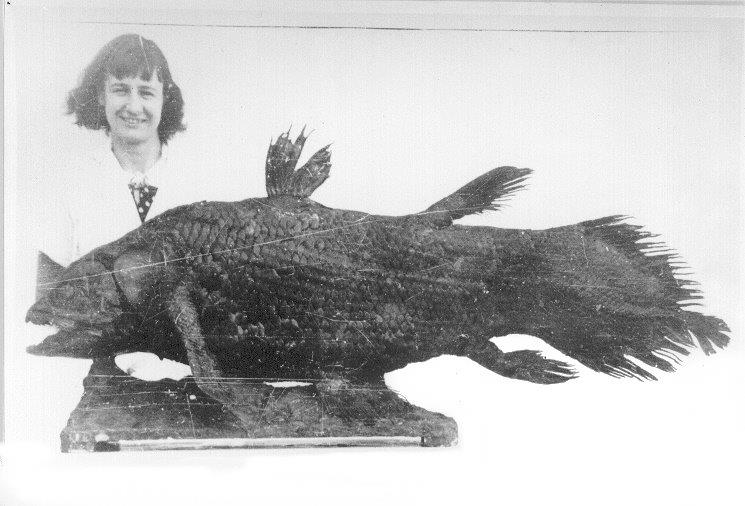 |
| No, that's not Popper. That's Marjorie Courtenay-Latimer and her dino-fish. [A] |
On December 23, 1938, while visiting her friend captain Hendrick Goosen, Marjorie Courtenay-Latimer (curator of the provincial natural history museum of East London -- northeast of Cape Town, South Africa) accidentally discovered, part-hidden under Goosen's daily catch, a fairly large, odd-looking fish.
She didn't know it then, but she had found a coelacanth: a lobe-finned fish more closely related to amphibians than to ray-finned fish. Until then, paleontologists believed all similar fish extinct since the Late Cretaceous, 66 million years ago.
 |
| [B] |
A gifted amateur, but an amateur nonetheless, Courtenay-Latimer was not testing anything and, given lack of means and support, almost could not take advantage of her finding; however, her one freshly caught coelacanth disproved the hypothesis -- uncontroversial among paleontologists -- that coelacanths died out millions of years ago.
This is a textbook example of falsificationism in action, yes? Let's summarise:
- Paleontologists hypothesised that coelacanths were extinct (because no evidence of their existence had ever been reported before Courtenay-Latimer).
- That kind of evidence (more precisely, lack thereof) never offers absolute certainty: it can always, in principle, be disproven.
- The hypothesis, therefore, is scientific.
- Albeit by accident, Courtenay-Latimer falsified that hypothesis, thereby adding to scientific knowledge. Paleontologists did not search for ad hoc justifications for their failed prediction; instead, they gladly embraced the falsifying finding and moved on. In just recognition of her contribution, the genus was named Latimeria.
----------
When scientists declare any species extinct they can never speak with absolute certainty: they are formulating a falsifiable hypothesis. In fact, any extinction announcement is identical to an example both Popper and Robinson used: how to prove the hypothesis that all swans are white.
Both argue that to prove "all swans are white" is essentially impossible on empirical grounds: a single non-white swan disproves the hypothesis. Exactly the same applies to any extinction hypothesis: a single freshly caught coelacanth disproved that extinction hypothesis.
And the coelacanth is not an isolated case: by coincidence, two species of the genus Aipysurus (foliosquama, aka leaf-scaled sea snake, and apraefrontalis, aka short-nosed sea snake) were in the headlines a couple of weeks ago.
This is where two subtle problems appear in Popper's analysis.
First: It may take extreme good luck to test a falsifiable hypothesis -- as the coelacanth example shows. Evidence may be very unlikely to get (so it seems with string theory); if it appears, there may not be anybody around to collect it.
Popper apparently never considered that (or at least, bothered to write about it) but a false hypothesis could be falsifiable, but its falsification so unlikely as to never happen: the false hypothesis would forever remain unfalsified. The false hypothesis of the coelacanth extinction was only falsified by accident.
Under those circumstances, there may be little one can assert about a species' extinction (or about string theory).
Second: The falsified coelacanth extinction hypothesis did not force anybody to consider evolutionary biology -- in toto -- disproven. It wouldn't make sense to do so. However, when it comes to judge Marxist economics, Popper had no doubts: it once was a scientific hypothesis, but it was empirically falsified in toto (at least, so did he claim); worse, its supporters searched for justifications, thereby rendering it unfalsifiable.
Personally, I don't buy into falsificationism. Whatever the risk of being proven wrong, I side with paleontologists, zoologists, ecologists, botanists. But if one does buy into falsificationism, I see no alternative, one must consider extinction hypotheses at best borderline pseudo-scientific. This, as the link above indicates, is something extinction hypotheses have in common with string theory. Popperians through and through should comment on that and why they are in a best position to judge than scientists.
----------
To be honest, that sounds perfectly reasonable to me: those creatures seem extremely improbable (but then again, so did coelacanths before being found).
"Reasonable" and "improbable", however, are not good enough for Popper or Robinson, they demand more: absolute certainty. The likelihood of finding a non-avian dinosaur in the Republic of Congo, for example, may be tiny, but it's not zero. Personally, I find it extremely unlikely that plesiosaurs survived in Scotland (they must be viviparous and endothermic). However unlikely, a single discovery can disprove with absolute certainty the scientists' claims: the true-life coelacanth example proves that. Isn't that what Popperian scientific hypotheses are for?
Like the experts, I wouldn't recommend anybody to go out there and start searching but -- who knew? -- cryptozoology (usually considered pseudo-science), seems not only compatible with Popper's falsificationism at its textbook example best, but it appears falsificationism actually lends it support. (Which explains cryptozoologists' justified interest on coelacanths).
Furthermore, if you think about it, things don't seem much different with UFOlogy.
It would be an interesting spectacle to see Very Serious Philosophers of Science dedicated to such unconventional research, but, as FBI special agent Fox Mulder, from the TV series "The X-Files" used to say: "The truth is out there".
Unfortunately for physicists, through Popperian lenses, string theory and multiverses (not to mention dark matter and energy) may look less scientific than cryptozoology.
----------
It's not only that silver bullets shot in the dark sometimes hit those one likes: sometimes they may be used by those one doesn't like.
Image Credits:
[A] Licensor: The South African Institute for Aquatic Biology (SAIAB, www.saiab.ac.za). My usage of the image does not imply in any way SAIAB's endorsement. File licensed under the Creative Commons Attribution-Share Alike 3.0 Unported license.
[B] "Late Devonian vertebrate speciation; descendants of pelagic lobe-finned fish including early tetrapods as well as other lobe-finned fish." "Graphic by dave souza, incorporating images by others." My usage of the image does not imply dave souza's or anybody's endorsement. File licensed under the Creative Commons Attribution-Share Alike 3.0 Unported license.
No comments:
Post a Comment